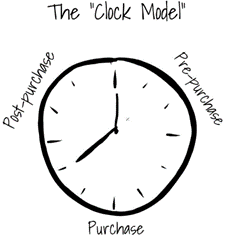RAIC Insights: Correctly map the customer journey and identify publisher touchpoints for added value
The latest addition to Rakuten Advertising’s RAIC Insights series sees Simon Bird share his tips on how to correctly map the customer journey.

The Rakuten Advertising International Collective (RAIC) aims to showcase the strategies and steps that will elevate your affiliate thinking, giving you the tools to outthink the market and deliver campaigns that outperform for your business. In our latest post, Simon Bird, CEO and Co-founder of RevLifter reveals how to correctly map the customer journey and identify publisher touchpoints for added value.
Gone are the days of a streamlined, linear customer journey. As a result, any conversation around precisely where certain publishers add value needs some stage setting.
To provide the framework for our touchpoints, we’ll start with Scott Galloway’s ‘clock framework’:

- Pre-purchase: 12-4. Building awareness is the aim of the game. Advertising and referrals happen here.
- Purchase: 4-8. This is where the customer first interacts with a brand and makes a purchase.
- Post-purchase: 8-12. Once a purchase is made, loyalty and customer service come into play.
Back in 2008, when affiliate marketing grew exponentially in light of the economic downturn, publishers occupied prime position between the pre-purchase and purchase phases. Content, cashback, and voucher sites directed crowds of traffic to advertisers, who were left to convert their new audiences.
Publishers have since evolved to the point of covering more and more bases, which has shattered a linear view of where they add value. Take the example of ‘incentive publishers’ like cashback and voucher sites, which now have browser extensions which overlap on retail sites.
Then we have the introduction of new publisher types, like tech partners. Many of these tools help to optimise conversions. They live on the advertiser’s site and are embedded in the purchase phase.
In essence, publishers now cover a much greater proportion of channels and touchpoints, but there are definitely some that have qualities in certain areas:
Pre-purchase: Content, influencer, incentive
In the pre-purchase phase, there is a huge opportunity for content publishers and influencers to add value.
Most of the time, content and influencers are remunerated on their ability to do two things:
- Drive traffic to an advertiser’s site
- Drive brand awareness for the advertiser
Some podcasts, blogs, and social media accounts have millions of followers. By tapping into these audiences with a paid placement, the advertiser ultimately puts eyes on its brand. However, there is a strong chance of also driving traffic and sales by issuing discount codes to these publishers.
Another mention should go to incentive publishers for bridging the gap between high-intent customers and brands. These publishers have huge mailing lists that push out the latest deals and cashback rates, which could persuade a customer to purchase from a brand they hadn’t considered.
Arguably, there is some role in the purchase phase too. Customers find these sites by heading to Google in search of discount codes and cashback for specific brands, often while browsing the retailer’s site on another tab.
Purchase: Tech partner
When the traffic has been acquired, tech partners have a major role in ensuring it converts. These solutions often engage with customers on the advertiser’s website and span the entire purchase phase. I’ll use two very different examples to demonstrate this:
RevLifter: Serves personalized offers through various on-site tools
RevLifter triggers personalized offers, recommendations, and messages whenever the advertiser’s goals can be driven. For instance, if the advertiser wants to convert bigger carts, the technology might serve an overlay to a customer, encouraging them to spend more for a better saving.
Klarna: Offers the chance for customers to spread out their payments
‘Buy-now-pay-later’ partners like Klarna tend to operate at the end of the purchase phase. It’s in the ‘make or break’ window where the customer could abandon their cart if the cost seems too high. Klarna offers the chance to space out that cost over time, which makes the purchase more feasible.
The growth of tech partners has been driven by affiliate networks like Rakuten Advertising, which have made it quick and simple for them to go live by allowing their integration within their SPI network container tags. Due to the time it takes to go live, and the chance to pay on performance, there is a serious case for using tech partners rather than building the same technology in-house.
Post-purchase: Brand partnerships, loyalty partners
Once the customer has converted, there is a whole other phase that often gets overlooked.
Brand-to-brand partnerships are incredibly important in the post-purchase phase. The idea is that advertisers can unlock a new stream of revenue by referring customers to other advertisers.
Think about a hotel group that has recently accepted a booking at one of its locations. A car hire firm or travel insurer would be extremely interested in reaching out to that customer.
Loyalty and Reward partners, including cashback, also operate in the post-purchase phase by helping brands drive repeat sales, either for their own business or through a brand partnership.
As you can see, publishers have a role to play in each stage of the customer journey. Once a firm consideration in the pre-purchase phase, they now provide ample coverage in all the important areas, which makes performance marketing all the more compelling to advertisers.
Keep up-to-date with the latest insights from RAIC by subscribing to our blog.


